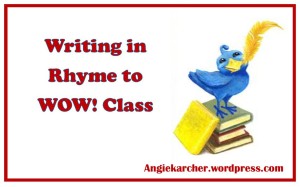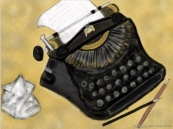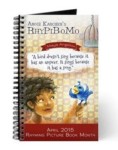Welcome to
RhyPiBoMo 2015 Day 16
Dianne White
*
Today’s guest blogger is a wonderful author with whom I’ve had the pleasure of meeting last summer at the L.A. SCBWI Conference. She has had great success early on as her debut picture book, BLUE ON BLUE, had received much national attention. I was a judge for a Mock Caldecott award ceremony in my area and Diane’s book was on my list to read and vote on…SO cool! I wish her the best of luck and can’t wait to see what she gives us next.
I am so happy
to
introduce
Dianne White
*
The Sound and The Feeling and How to Get There
*
*
Each syllable, each line break, each sentence’s placement on the page … the rhythm, the word choice, the repetition (and maybe even the rhyme, if it’s done well) — all of these are massively important… The read-aloud experience should be so extraordinary that practically as soon as the book is closed, everyone just wants to open it up and do it again.
–from “Why We’re Still in Love with Picture Books (Even Though They’re Supposed to Be Dead),” May/June 2011 Horn Book
One of the first things a picture book writer learns is that each word must earn its place. So how does a writer know which words to choose and how to arrange those words to add to the sound and feeling of a piece? How does a writer get “there” – that undefined but immediately recognizable story place that captures not only the voice and structure you aimed for, but the emotional feeling you intended to leave with readers?
And how does a writer know if the words should rhyme?
Perhaps the easiest answer is – it depends. On the story. On the writer. On the ways the tools of poetry – those very syllables, line breaks, words, rhythms, and sentences – are put together.
According to Oliver Sacks, M.D. noted neurologist and author, our brains are wired for sound. It’s such an effective way to remember and learn new things, that it’s not surprising that young children are taught rhymes and songs at an early age. But the powerful connection between music and words isn’t limited to rhyme. Prose needs to sing, too. And it can. With the tools of poetry.
In Awakening the Heart: Exploring Poetry in Elementary and Middle School, Georgia Heard divides these tools  into Meaning and Music.
into Meaning and Music.
First, MEANING:
* A WORD reflects not only its denotation or literal meaning, but also its connotation, or implied subtext. Choosing the best words means looking for words that do double duty. Words that shed light not only on character or setting, for example, but also mood or tone.
Kevin Henkes is a master at this. Take CHRYSANTHEMUM. She’s an over-the-top mouse in love with her name.
 “She loved the way it sounded when her mother woke her up.
“She loved the way it sounded when her mother woke her up.
She loved the way it sounded when her father called her for dinner.
And she loved the way it sounded when she whispered it to herself in the bathroom mirror.
Chrysanthemum, Chrysanthemum, Chrysanthemum.”
Longer sentences, repetition, and the rule of three help convey the voice of the entire piece and something of Chrysanthemum’s own exuberance for life.
* The ORDER, or arrangement and length of the words, affect a reader’s response.
Characters can skip, dash, or march… saunter, shuffle, or waddle. The latter three not only describe a slower pace, but are two syllables long and take longer to say or read. In other words, the words themselves embody the slower pace they describe.
Next, MUSIC:
The link between Meaning and Music is simply that the SOUND of a carefully chosen word can amplify meaning and deepen the emotional layers of story.
Think of the alphabet as families of sounds, each conveying something slightly different. For example, some letters in English produce a harsh sound, others a soft sound.
Now, consider how letter/sound combinations work in the context of words, phrases, and sentences. Mary Oliver writes:
The following three phrases mean exactly the same thing:
-
Hush!
-
Please be quiet!
-
Shut up!
The first phrase we might use to quiet a child when we do not want to give any sense of disturbance or anger. [The “sh” sound at the end of the word “hush” is soft, though slightly abrasive.]
The second phrase is curt, but the tone remains civil… [In particular, the “t” at the end of “quiet” is a harsh, hard stop.]
The third phrase indicates … impatience and even anger. [In this case, the “t” and “p” at the end of both words produce two hard stops.]
(adapted from A Poetry Handbook, 23-24)
And finally, consider how the Music of individual phrases and sentences supports Meaning through another tool – the up and down patterns of speech known as RHYTHM. A boisterous or silly story deserves a rising (iamb or anapest) rhythm. A story about childhood fears might use falling (trochee or dactyl) rhythms.
In my book, BLUE on BLUE, when the rain is at its strongest, a falling trochee rhythm mirrors the endless heaviness of the storm.
/ – / –
Pounding, hounding,
/ – / –
noisy-sounding.
/ – / –
Dripping, dropping.
/ – / –
Never stopping.
You can learn more about the sounds of letters and letter combinations in Mary Oliver’s A Poetry Handbook (“Sound,” chapter 4) and Ann Whitford Paul’s Writing Picture Books (“Making Music with Your Prose,” chapter 14).
So how does a writer get to the “sound and the feeling” of the best of the best picture books? By studying and using the tools of poetry. Picture books don’t always rhyme and they don’t have to. But look closely and you’ll find the author – consciously or unconsciously – has used many of a poet’s tools to place the best words in their best order.
*
*
About Dianne:
DIANNE WHITE has lived and traveled around the world and now calls Arizona home. She holds an elementary bilingual teaching credential and a master’s in Language and
Literacy. In 2007, she received her MFA in Writing for Children and Young Adults
from Vermont College of Fine Arts. After teaching students of all ages for 25 years, she now writes full-time. Her first picture book, BLUE ON BLUE, illustrated by 2009 Caldecott winner, Beth Krommes, was published by Beach Lane Books (S&S) in 2014.
RhyPiBoMo 2015 Optional Writing Prompt: 16
*
This is NOT part of the pledge. It is an option for a writing exercise for those interested. You will not publically share this as part of RhyPiBoMo but may keep a journal of your writing this month for your own review.
*
Today’s writing prompt is to write a poem about rain with the best words in their best order.
For example:
Happily Damp
*
A drop
a splash…then two, then three.
Where shall I go?
Where shall I be?
The drops are dampening my hair
I stop, then run…without a care.
It’s water falling from the sky.
Why did I run?
I’m not sure why.
‘Cause when I’m wet I feel …not dry.
But, it’s okay…
because I see
the happy girl I’d hoped to be.
© 2015 Angie Karcher
Okay, these are spur of the moment poem examples…can you tell? = )

Congratulations to Week 3 Prize Winners
*
Monday Copy of THE BOAT OF MANY ROOMS Donated by J. Patrick Lewis
Winner – Ann Magee
Tuesday Copy of GROUNDHOG’S DILEMMA (Dec/2015) Donated by Kristen Remenar
Winner – Aimee Haburjak
Wednesday Manuscript Critique by Kristen Remenar
Winner – Kenda Henthorn
Thursday Manuscript Critique by Iza Trapani
Winner – Kristi Veitenheimer
Friday Manuscript Critique by Tim McCanna
Winner – Caroline Twomey
Winners, PLEASE message me your information on Facebook
or email it to Angiekarcherrpbm@gmail.com
**
*
Golden Quill Poetry Contest
The Golden Quill Poetry Contest is open for submissions.
The deadline is this Saturday, April 25th midnight Central Time.
And…did I mention the prizes?
1st place – A Manuscript Critique by Sudipta Bardhan-Quallen
2nd place – A Scholarship for Non-Fiction Archeology by Kristen Fulton
3rd place – A Scholarship for Pacing Picture Books to WOW! Class by Agent Jodell Sadler
*
PLEASE make sure you read the contest rules and follow them exactly. Unfortunately, due to the number of poems we will receive, a poem will be disqualified if it does not follow the guidelines exactly. This is only fair to those who did follow the rules and is good practice for us as writers because editors expect those guidelines to be followed to the letter.
*
Contest Rules:
First and Last name included in the body of the email at the top left
Email address included in the body of the email at the top left
Phone number – top left
Space down 5 spaces
The Theme is: Freedom
Title of poem – centered with no by line or name here
8 line limit
Must be a rhyming poem
You will be judged on clever title, rhyme scheme, rhythm, scansion, perfect rhyming words, internal rhyme, alliteration, consonance, assonance, onomatopoeia, and clever ending.
Email poems to Angiekarcherrpbm@gmail.com
by April 25th midnight central time
*
*
*
Do you enjoy writing rhyming picture books?
Do you find rhyme challenging?
Do you want to pep up your prose with poetic techniques?
Then this is the class for you!
Writing in Rhyme to WOW! is a 4 week course,
M-F with daily lessons, writing prompts, rhyme journaling, creating tools you will use, group poetry readings, webinars and critique groups, and a one-on-one webinar critique with Angie.
Each class begins on the first Monday of the month and the weekly group webinars are on Thursdays at 8:00 p.m. Central Standard Time, (Chicago Time) or at a time that best suits the group due to time zones of those involved.
There are now 2 spots left in May!
I am beginning to sign people up for June and July!
If you register now for June or July, I will give you the $99.00 price!
Contact Angie with questions.
Sign up now before the classes are full!
Click here for more information!
*
*
*
Need a critique?
Angie is now offering
rhyming picture book and poetry manuscript critiques.
A One Time critique is ($25.00) or a Twice Look critique is ($35.00)
See the tab above or click here for more information.
*
*A
RhyPiBoMo Gift Shop is Open!
http://www.cafepress.com/rhypibomogiftshop
Please stop by and see what’s available this year. There are notebooks, mugs, buttons and more. All proceeds will go to WE NEED DIVERSE BOOKS!
Thank you Tanja Bauerle for these gorgeous images!!!
*
*







Have fun revising your WIP, Maria. Revision can be hair-pulling (especially when writing in rhyme), but it’s also a challenging puzzle and, for me, often the best part of the process.
Vicki Wilke
Great information Dianne – the beautiful sound of language / prose / poetry definitely sings to children – and all of us. I have BLUE on BLUE – lovely book! Also enjoyed your references to Georgia Heard and Mary Oliver – two of the best!
Thanks, Vicki! I agree. Nothing beats those two poets (and their many books)!
Cindy Argentine
I was struck by your concept of “there” – that “immediately recognizable story place that captures not only the voice and structure you aimed for, but the emotional feeling you intended to leave with readers.” We know the place when we discover it, and it’s magical when we sense we are getting close to creating it. Thanks so much for this thoughtful post on how to use poetic tools to move toward the magnetic, mysterious “there.”
It’s true, Cindy. We (mostly) know when we’ve reached that story place and the longer I work at writing books for kids, the more I realize I need to pay attention to that internal voice that tries to point me in this or that direction. I’m often impatient and just want to be “done,” but it doesn’t always work that way. Listening to our work and taking whatever time a revision needs is what will get us to our best work.
Shirley Johnson – This was very informative. Thanks for posting.
Thanks for stopping by, Shirley!
Charlotte Dixon
“The sound and the feeling and how to get there” sings eloquently-love this Dianne 🙂 Thank you for sharing your voice with us. Love BLUE ON BLUE!
Thanks so much, Charlotte! Happy writing to you!!
Ginger Weddle – Dianne, Thank you for this great post about “the Sound and the Feeling and How To Get There”! This is so thoughtful and well organized. It’s very helpful! And I love the reference to Oliver Sacks! I’m looking forward to reading BLUE ON BLUE.
Thanks, Ginger. Glad it was helpful. Here’s to musical writing for us all!
Dianne thanks for sharing the subtle difference in word choice. How that affects word choices
Therese Nagi
Thanks for stopping by, Therese!
Janet Smart. Enjoyed this post. Words are so important and must be picked out, pondered on and perfect!
Love that alliteration, Janet!! Write on!
Thanks for the post and for reminding us how important each word is to our story. Katie Gast
Word choice is so important, isn’t it? All the more so in picture books. So much has to be conveyed in such a short space. Happy writing!
Patricia Toht: Thank you, Dianne, for your tips on how to get “there” with our texts. It’s amazing what a change in word choice can do to the rhythm and feel of a story. The Mary Oliver example really sums this up.
Thanks, Patricia! Mary Oliver has it covered, doesn’t she? I know you love her book, A Poetry Handbook, as much as I do!
Rule one “words are important” I had an English grammar book in high school by that title – the exercises always “looked” easy…a lot of though went into those assignments . Thanks for your ideas
Jennifer McRae
I bet I would love that book, Jennifer! Thanks for stopping by!
Natasha Garnett
Thank you, Dianne, and congratulations on Blue on Blue. I stumbled upon it a couple of months ago at our local library. Very nice.
Ann W. Paul’s book is one of my favorites.
Thanks, Natasha! Ann Paul is a gem. I learned so much of what I know about picture books from her.
Thank you for breaking these elements down for us, Dianne. I still don’t feel confident identifying them for myself when reading rhyme, but with practice and guidance from RhyPiBoMo authors like you, I’ll get there.
We’re all learning, Sarah. That’s a given! The kid lit community is especially wonderful, so you *will* get there, and you’re sure to meet a lot of wonderful people along the way. 🙂
Ann Magee. Thanks, Dianne, for the informative post. Love Georgia Heard and Ann W. Paul! I’m still training my ear as I struggle with meter, but being a poet first has surely helped with my pb prose.
I struggle with meter, too, Ann. Sometimes what sounds right to my ear doesn’t quite match up, so I have to go back and rethink, revise and rethink some more. Happy writing!
I had the pleasure of finding Blue on Blue at the library today. What wonderful words! Thank you.
Darlene Ivy
Thanks, Darlene! Glad you liked it. 🙂
Lori Mozdzierz:
A bookmark post for sure!
Thanks for stopping by, Lori!
This so clearly illustrates the importance of careful word and meter choices. Thank you, Dianne! -Sydney O’Neill
Thanks, Sydney!